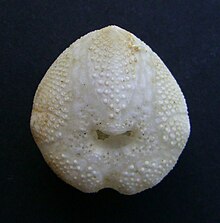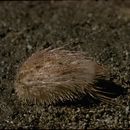Brief Summary
provided by Ecomare
The sea potato is a large, heart-shaped sea urchin. It is sometimes referred to as a heart urchin. You often see pieces of its bare and very breakable skeleton on the beach. A live sea potato has lots of spines which are flattened across its body. Its spines are shorter than by sea urchins and look more like hair than spines. Actually, it looks a lot like a hairy potato.
- license
- cc-by-nc
- copyright
- Copyright Ecomare
Echinocardium australe
provided by wikipedia EN
- license
- cc-by-sa-3.0
- copyright
- Wikipedia authors and editors
Echinocardium australe: Brief Summary
provided by wikipedia EN
Echinocardium australe, or the New Zealand heart urchin is a sea urchin of the family Loveniidae, endemic to New Zealand. Length is up to 40 mm.

Underside view of
test of Echinocardium australe
- license
- cc-by-sa-3.0
- copyright
- Wikipedia authors and editors
Biology
provided by World Register of Marine Species
Breeding occurs in summer. The pelagic larvae are sometimes found in enormous quantities and likewise the young can be found in large amounts on the sediment surface. The growth rate of E. cordatum varies with the environment. It grows faster in shallow, sandy than in deep, muddy areas, possibly under the influence of temperature. The species can live for 10 to 20 years (Mortensen, 1927; Wolff, 1973; Fish & Fish, 1989; Rees & Dare, 1993). Depending on the temperature, the species digs a few centimetres to about 20 cm deep into the sediment. A respiratory channel (chimney) leads from the hole to the surface and one or two sanitary drains are located horizontally behind the echinoid. The animal is isolated from the sediment by a mucus veil, which plasters the burrow. E. cordatum plays an important role in sediment bioturbation (Mortensen, 1927; De Ridder et al., 1987; Fish & Fish, 1989; Rees & Dare, 1993). E. cordatum is a non-selective deposit feeder. lt collects particles from the s
Holtmann, S.E.; Groenewold, A.; Schrader, K.H.M.; Asjes, J.; Craeymeersch, J.A.; Duineveld, G.C.A.; van Bostelen, A.J.; van der Meer, J. (1996). Atlas of the zoobenthos of the Dutch continental shelf. Ministry of Transport, Public Works and Water Management: Rijswijk, The Netherlands. ISBN 90-369-4301-9. 243 pp.
- license
- cc-by-4.0
- copyright
- WoRMS Editorial Board
Breeding
provided by World Register of Marine Species
Echinopluteus larva. Summer
Depth range
provided by World Register of Marine Species
0-230 m
Description
provided by World Register of Marine Species
The cordiform body of the sea potato is protected by a calcite skeleton and measures up to 60 mm. The skeleton is covered with soft spines that lie flat on the body and point towards the back. Yellowish brown in colour.
Degraer, S.; Wittoeck, J.; Appeltans, W.; Cooreman, K.; Deprez, T.; Hillewaert, H.; Hostens, K.; Mees, J.; Vanden Berghe, E.; Vincx, M. (2006). The macrobenthos atlas of the Belgian part of the North Sea. Belgian Science Policy. D/2005/1191/3. ISBN 90-810081-6-1. 164 pp.
- license
- cc-by-4.0
- copyright
- WoRMS Editorial Board
Distribution
provided by World Register of Marine Species
Cosmopolitan (World Oceans)
Distribution
provided by World Register of Marine Species
This cosmopolitan echinoderrn was found in about half of all samples. The species is very abundant north of the Dutch Wadden islands and is also present in Delta and the western part of the Wadden Sea. The distribution of the biomass is very patchy.
Holtmann, S.E.; Groenewold, A.; Schrader, K.H.M.; Asjes, J.; Craeymeersch, J.A.; Duineveld, G.C.A.; van Bostelen, A.J.; van der Meer, J. (1996). Atlas of the zoobenthos of the Dutch continental shelf. Ministry of Transport, Public Works and Water Management: Rijswijk, The Netherlands. ISBN 90-369-4301-9. 243 pp.
- license
- cc-by-4.0
- copyright
- WoRMS Editorial Board
Distribution
provided by World Register of Marine Species
In the 1976-1986 period Echinocardium cordatum was mainly found near the Flemish Banks (maximum 50 ind./m2) whereas it was absent in the eastern coastal zone and near the Hinder Banks. In the 1994-2001 period the species is clearly distributed more widely: E. cordatum was only absent in the eastern coastal zone and reached densities up to 200 ind./m2. As the species lives burrowed in the sand (up to 20 cm deep) there is a real chance that the Van Veen grab fails to scoop up E. cordatum. Consequently, the species may have a broader distribution than mentioned here.
Degraer, S.; Wittoeck, J.; Appeltans, W.; Cooreman, K.; Deprez, T.; Hillewaert, H.; Hostens, K.; Mees, J.; Vanden Berghe, E.; Vincx, M. (2006). The macrobenthos atlas of the Belgian part of the North Sea. Belgian Science Policy. D/2005/1191/3. ISBN 90-810081-6-1. 164 pp.
- license
- cc-by-4.0
- copyright
- WoRMS Editorial Board
Distribution
provided by World Register of Marine Species
Lower shore and subtidal to 200 m depth, burrowing in sand or muddy sand, all round the British Isles. Apparently cosmopolitan in temperate seas
Ecology
provided by World Register of Marine Species
Ecology: benthic, inshore, continental shelf, deposit feeder. General distribution: temperate, discontinuous (west Pacific Ocean, NZ, South Africa, Gulf of California, north Atlantic Ocean), depth range 0-230? m. (Rowe & Gates, 1995). Also distributed in Australia (Rowe & Gates, 1995).
5. Courtecuisse, R. (1999)
Collins mushrooms of Britain and Europe. HarperCollins Publishers, London.
- license
- cc-by-4.0
- copyright
- WoRMS Editorial Board
Habitat
provided by World Register of Marine Species
The fact that E. cordatum is present in the entire area (North Sea) indicates that the echinoderm is not very selective with regard to the type of sediment, although a slight preference for sandy bottoms can be detected. Earlier investigations suggest that, indeed, sandy substrates may be favoured (Rees & Dare, 1993). In a study along a transect in the central and southern North Sea, Duineveld & Jenness (1984) found E. cordatum to account for 50% of the benthic biomass at sandy sites and 5% at muddy sites.
Holtmann, S.E.; Groenewold, A.; Schrader, K.H.M.; Asjes, J.; Craeymeersch, J.A.; Duineveld, G.C.A.; van Bostelen, A.J.; van der Meer, J. (1996). Atlas of the zoobenthos of the Dutch continental shelf. Ministry of Transport, Public Works and Water Management: Rijswijk, The Netherlands. ISBN 90-369-4301-9. 243 pp.
- license
- cc-by-4.0
- copyright
- WoRMS Editorial Board
Habitat
provided by World Register of Marine Species
Echinocardium cordatum occurs in sediments with a wide range of grain sizes (median grain size up to 650 µm), but clearly prefers sediments with a median grain size of 200 to 300 µm (relative occurrence ± 40%). The species is only found in sediments with a low mud content (< 20%).
Degraer, S.; Wittoeck, J.; Appeltans, W.; Cooreman, K.; Deprez, T.; Hillewaert, H.; Hostens, K.; Mees, J.; Vanden Berghe, E.; Vincx, M. (2006). The macrobenthos atlas of the Belgian part of the North Sea. Belgian Science Policy. D/2005/1191/3. ISBN 90-810081-6-1. 164 pp.
- license
- cc-by-4.0
- copyright
- WoRMS Editorial Board
Morphology
provided by World Register of Marine Species
This sea urchin has a heart-shaped test, usually 40-50 mm in length. lt is covered with a large number of closely set spines, most of them directed backwards. In profile the highest point of the test lies towards the posterior. lt is yellow-brown in colour (Mortensen, 1927; Southward, 1972; Fish & Fish, 1989; Hayward & Ryland, 1990).
Holtmann, S.E.; Groenewold, A.; Schrader, K.H.M.; Asjes, J.; Craeymeersch, J.A.; Duineveld, G.C.A.; van Bostelen, A.J.; van der Meer, J. (1996). Atlas of the zoobenthos of the Dutch continental shelf. Ministry of Transport, Public Works and Water Management: Rijswijk, The Netherlands. ISBN 90-369-4301-9. 243 pp.
- license
- cc-by-4.0
- copyright
- WoRMS Editorial Board



 Underside view of test of Echinocardium australe
Underside view of test of Echinocardium australe